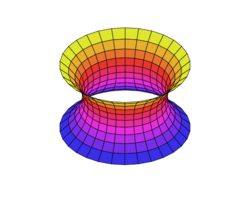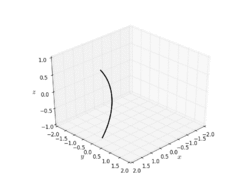Catenoid


In geometry, a catenoid is a type of surface, arising by rotating a catenary curve about an axis (a surface of revolution).[1] It is a minimal surface, meaning that it occupies the least area when bounded by a closed space.[2] It was formally described in 1744 by the mathematician Leonhard Euler.
Soap film attached to twin circular rings will take the shape of a catenoid.[2] Because they are members of the same associate family of surfaces, a catenoid can be bent into a portion of a helicoid, and vice versa.
Geometry
The catenoid was the first non-trivial minimal surface in 3-dimensional Euclidean space to be discovered apart from the plane. The catenoid is obtained by rotating a catenary about its directrix.[2] It was found and proved to be minimal by Leonhard Euler in 1744.[3][4]
Early work on the subject was published also by Jean Baptiste Meusnier.[5][4]:11106 There are only two minimal surfaces of revolution (surfaces of revolution which are also minimal surfaces): the plane and the catenoid.[6]
The catenoid may be defined by the following parametric equations: where and and is a non-zero real constant.
In cylindrical coordinates: where is a real constant.
A physical model of a catenoid can be formed by dipping two circular rings into a soap solution and slowly drawing the circles apart.
The catenoid may be also defined approximately by the stretched grid method as a facet 3D model.
Helicoid transformation

Because they are members of the same associate family of surfaces, one can bend a catenoid into a portion of a helicoid without stretching. In other words, one can make a (mostly) continuous and isometric deformation of a catenoid to a portion of the helicoid such that every member of the deformation family is minimal (having a mean curvature of zero). A parametrization of such a deformation is given by the system for , with deformation parameter , where:
- corresponds to a right-handed helicoid,
- corresponds to a catenoid, and
- corresponds to a left-handed helicoid.
References
- ↑ Dierkes, Ulrich; Hildebrandt, Stefan; Sauvigny, Friedrich (2010) (in en). Minimal Surfaces. Springer Science & Business Media. p. 141. ISBN 9783642116988. https://books.google.com/books?id=9YhBOg6vO-EC&pg=PA141.
- ↑ 2.0 2.1 2.2 Gullberg, Jan (1997) (in en). Mathematics: From the Birth of Numbers. W. W. Norton & Company. p. 538. ISBN 9780393040029. https://archive.org/details/mathematicsfromb1997gull.
- ↑ Helveticae, Euler, Leonhard (1952). Carathëodory Constantin. ed (in Latin). Methodus inveniendi lineas curvas: maximi minimive proprietate gaudentes sive solutio problematis isoperimetrici latissimo sensu accepti. Springer Science & Business Media. ISBN 3-76431-424-9. https://books.google.com/books?id=zNDdVFZalSAC.
- ↑ 4.0 4.1 Colding, T. H.; Minicozzi, W. P. (17 July 2006). "Shapes of embedded minimal surfaces". Proceedings of the National Academy of Sciences 103 (30): 11106–11111. doi:10.1073/pnas.0510379103. PMID 16847265. Bibcode: 2006PNAS..10311106C.
- ↑ Meusnier, J. B (1881) (in French) (PDF). Mémoire sur la courbure des surfaces. Bruxelles: F. Hayez, Imprimeur De L'Acdemie Royale De Belgique. pp. 477–510. ISBN 9781147341744. https://archive.org/details/mmoiresurlathor00salvgoog.
- ↑ "Catenoid" (in en). http://mathworld.wolfram.com/Catenoid.html. Retrieved 15 January 2017.
Further reading
- Krivoshapko, Sergey; Ivanov, V. N. (2015). "Minimal Surfaces" (in en). Encyclopedia of Analytical Surfaces. Springer. ISBN 9783319117737. https://books.google.com/books?id=cXTdBgAAQBAJ&pg=PA427.
External links
- Hazewinkel, Michiel, ed. (2001), "Catenoid", Encyclopedia of Mathematics, Springer Science+Business Media B.V. / Kluwer Academic Publishers, ISBN 978-1-55608-010-4, https://www.encyclopediaofmath.org/index.php?title=p/c020800
- Catenoid – WebGL model
- Euler's text describing the catenoid at Carnegie Mellon University
- Calculating the surface area of a Catenoid
- Minimal Surface of Revolution
de:Minimalfläche#Das Katenoid
 |


